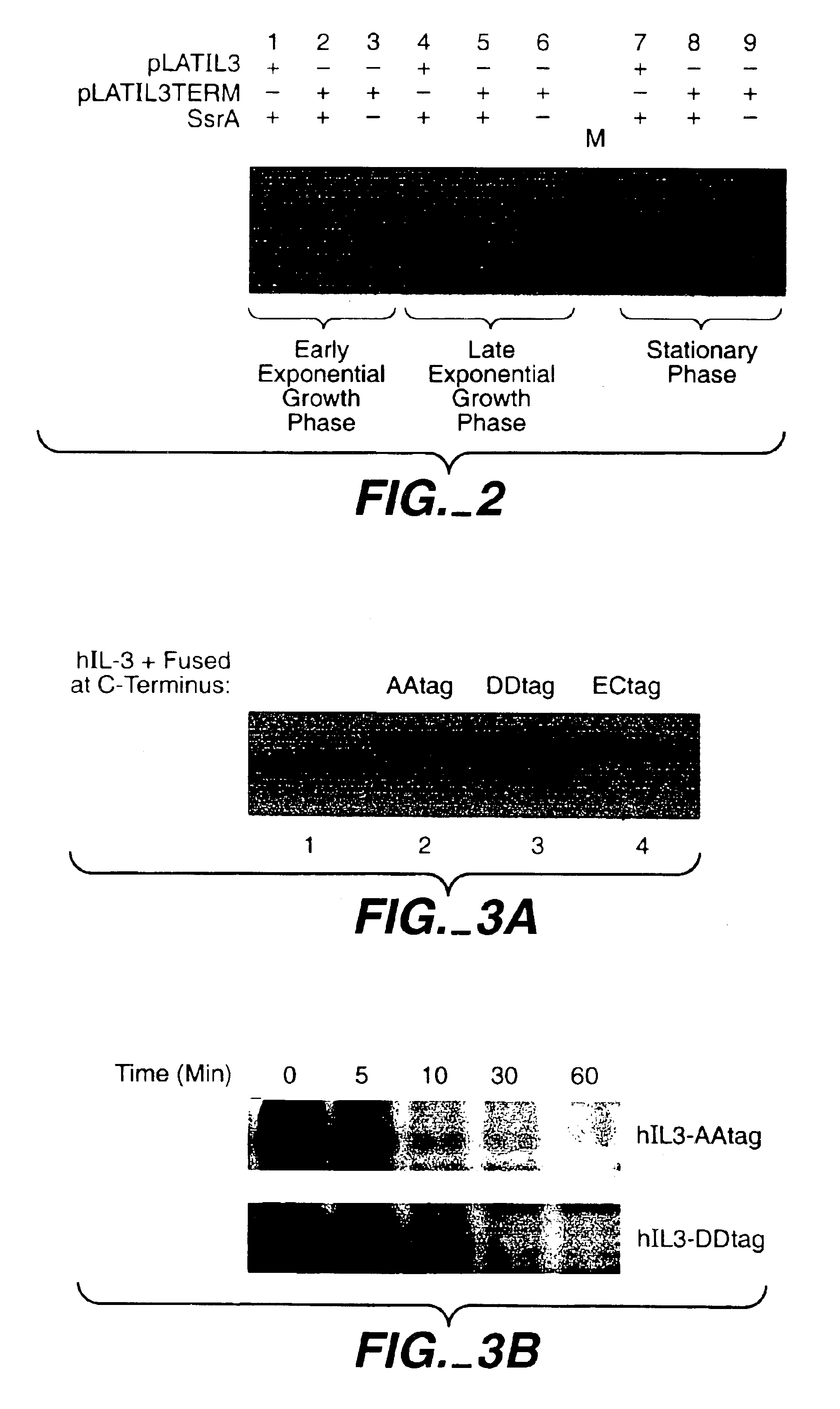Enhanced secretion of a polypeptide by a microorganism
- Summary
- Abstract
- Description
- Claims
- Application Information
AI Technical Summary
Benefits of technology
Problems solved by technology
Method used
Image
Examples
example 1
Plasmid Construction and Host Transformation
[0099]To study the degradation of SsrA-tagged proteins in B. subtilis, variants of pLATIL3 were made in which h-IL3 is expressed with different short peptide tags added to the COOH-terminus of h-IL3:[0100]Variant 1: plasmid pLATIL3-BStag; expresses the hIL3 variant hIL3-AA: hIL3 with an apolar C-terminal B. subtilis SsrA-tag [GKTNSFNQNVALAA] (SEQ ID NO:5)[0101]Variant 2: plasmid pLATIL3-DDtag; expresses the hIL3 variant hIL3-DD: hIL3 with a negatively charged C-terminal tag [GKTNSFNQNVALDD] (SEQ ID NO:6), this variant differs from variant 1 (hIL3-AA) only in the last two C-terminal amino acids (two aspartic acids (DD) instead of two alanine (AA) residues)[0102]Variant 3: plasmid pLATIL3-ECtag; expresses the hIL3 variant hIL3-ECAA: hIL3 with an apolar C-terminal E. coil SsrA tag [AANDENYALAA] (SEQ ID NO:3).
[0103]Plasmids, bacterial strains and media. Table I lists the plasmids and bacterial strains used in this study. E. coli strains were g...
example 2
IL-3 Expression
[0106]When fused to the signal peptide of B. licheniformis α-amylase, human interleukin-3 can be secreted by B. subtilis (Van Leen et al. (1991), Biotechnology, 9: 47-52). Plasmid pLATIL3 contains the h-IL3 gene fused to the coding region of the B. licheniformis α-amylase (AmyL) signal peptide; in this plasmid expression of the hybrid AmyL-hIL3 gene is controlled by the B. licheniformis α-amylase promoter. During secretion, the AmyL signal peptide is removed from the AmyL-hIL3 precursor by signal peptidases, and mature hIL3 is released into the medium.
[0107]Expression of the human IL-3 gene lacking an in-frame stop codon in wild-type B. subtilis and in an ssrA mutant. Mutant 168 ΔssrA was created, in which the ssrA gene is disrupted by insertion of a spectinomycin resistance cassette. The mutation was checked by PCR, and the absence of SsrA RNA in the mutant was confirmed by Northern blot analysis (FIG. 1A). Growth of 168 ΔssrA was somewhat reduced compared to the wil...
example 3
Enhanced Protease Resistance
[0110]A pulse-chase assay was performed with the strains B. subtilis 168 (pLATIL3-BStag) and B. subtilis 168 (pLATIL3-DDtag) (FIG. 2). NB: the h-IL3 variants expressed by these two strains (hIL3-AA and hIL3-DD) differ only in the last two COOH-terminal amino acids: two alanine residues in hIL3-AA and two aspartic acid residues for hIL3-DD. In the pulse-chase experiment, the initial level (pulse 1 min; chase 0′) of extracellular hIL3-DD proved to be roughly 5 times higher than that of hIL3-AA (compare lane 1 with lane 7). In addition, hIL3-AA proteins were degraded with half lives of <2 min, while the h-IL3-DD molecules had half-lives of approximately 5 min.
[0111]Protein labeling, SDS-PAGE, and fluorography. Pulse-chase labeling of B. subtilis and SDS-PAGE was essentially as described previously (Van Dijl et al. 1991. Non-functional expression of Escherichia coli signal peptidase I in Bacillus subtilis. J. Gen. Microbiol. 137:2073-2083). However, samples c...
PUM
| Property | Measurement | Unit |
|---|---|---|
| Temperature | aaaaa | aaaaa |
| Electric dipole moment | aaaaa | aaaaa |
Abstract
Description
Claims
Application Information
 Login to View More
Login to View More - R&D
- Intellectual Property
- Life Sciences
- Materials
- Tech Scout
- Unparalleled Data Quality
- Higher Quality Content
- 60% Fewer Hallucinations
Browse by: Latest US Patents, China's latest patents, Technical Efficacy Thesaurus, Application Domain, Technology Topic, Popular Technical Reports.
© 2025 PatSnap. All rights reserved.Legal|Privacy policy|Modern Slavery Act Transparency Statement|Sitemap|About US| Contact US: help@patsnap.com



